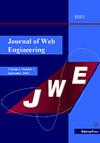A Web-Based Identification Method for Illegal Streaming Videos Using Low-Frequency Components of the Fast Fourier Transform
IF 1
4区 计算机科学
Q4 COMPUTER SCIENCE, SOFTWARE ENGINEERING
引用次数: 0
Abstract
With the proliferation of web-based content platforms, the distribution of illegally streamed videos poses a serious threat to the reliability of web applications and the integrity of content copyright protection systems. Traditional video identification methods typically require the processing of large-scale feature data, which hinders the real-time performance, lightweight nature, and scalability demanded by web environments. In this paper, we propose a method for identifying illegally streamed videos that is optimized for efficient operation within web systems. The proposed approach utilizes only the low-frequency components of the fast Fourier transform (FFT). By transforming video frames into the frequency domain and extracting the structurally significant low-frequency components, the method replaces high-dimensional feature data with more compact representations. This allows the system to maintain low computational complexity and fast response times, even in web application environments. Experimental results demonstrate that, compared to existing methods, the proposed technique achieves up to 93 times reduction in feature data size, a recognition rate of 98%, and an average response time of 1745 ms. From the perspective of web engineering, the proposed method holds strong potential as a real-time identification module in web-based copyright protection systems. It offers a balanced approach that satisfies both lightweight processing requirements and high accuracy.基于web的基于快速傅里叶变换低频分量的非法视频流识别方法
随着网络内容平台的激增,非法流媒体视频的传播对网络应用的可靠性和内容版权保护系统的完整性构成了严重的威胁。传统的视频识别方法通常需要处理大规模的特征数据,这阻碍了web环境所要求的实时性、轻量级和可扩展性。在本文中,我们提出了一种识别非法流媒体视频的方法,该方法经过优化,可在网络系统中高效运行。该方法仅利用快速傅里叶变换(FFT)的低频分量。该方法通过将视频帧变换到频域,提取结构显著的低频分量,用更紧凑的表示代替高维特征数据。这使得系统即使在web应用程序环境中也能保持较低的计算复杂度和快速的响应时间。实验结果表明,与现有方法相比,该方法将特征数据大小减少了93倍,识别率达到98%,平均响应时间为1745 ms。从网络工程的角度来看,该方法作为基于web的版权保护系统的实时识别模块具有很强的潜力。它提供了一种平衡的方法,既满足轻量级加工要求,又满足高精度。
本文章由计算机程序翻译,如有差异,请以英文原文为准。
求助全文
约1分钟内获得全文
求助全文
来源期刊

Journal of Web Engineering
工程技术-计算机:理论方法
CiteScore
1.80
自引率
12.50%
发文量
62
审稿时长
9 months
期刊介绍:
The World Wide Web and its associated technologies have become a major implementation and delivery platform for a large variety of applications, ranging from simple institutional information Web sites to sophisticated supply-chain management systems, financial applications, e-government, distance learning, and entertainment, among others. Such applications, in addition to their intrinsic functionality, also exhibit the more complex behavior of distributed applications.
 求助内容:
求助内容: 应助结果提醒方式:
应助结果提醒方式:


